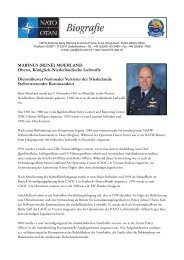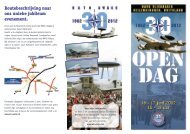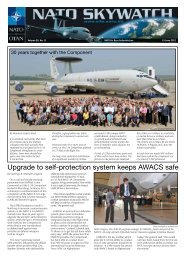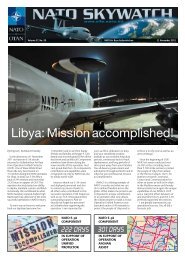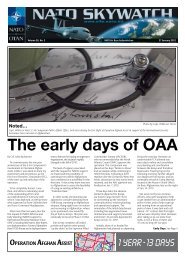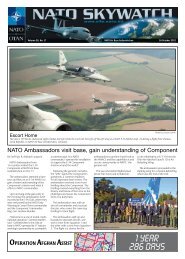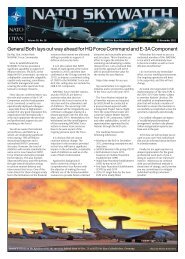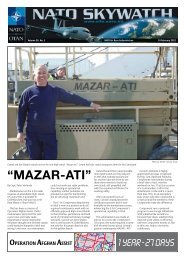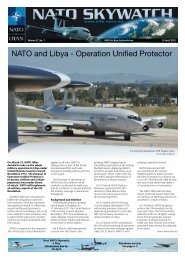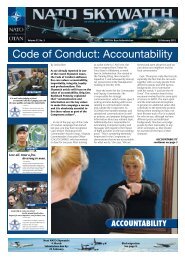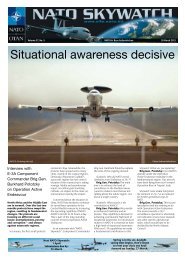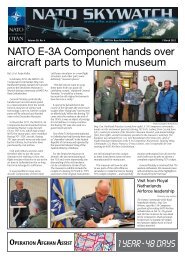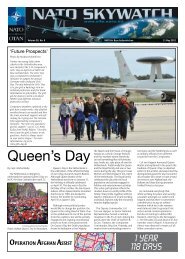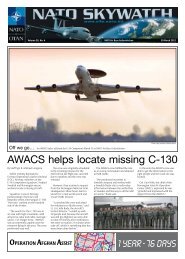Skywatch No. 08 - 27 Apr 2012 (pdf) - nato awacs
Skywatch No. 08 - 27 Apr 2012 (pdf) - nato awacs
Skywatch No. 08 - 27 Apr 2012 (pdf) - nato awacs
You also want an ePaper? Increase the reach of your titles
YUMPU automatically turns print PDFs into web optimized ePapers that Google loves.
One of the many take-offs during the evaluation which required round-the-clock flight operations from Geilenkirchen, Oerland and Trapani.<br />
From the <strong>Skywatch</strong> Archives<br />
Editor’s <strong>No</strong>te: This story was featured<br />
in <strong>Skywatch</strong> Volume 5, Number 8. This<br />
story is re-printed, in its entirety, how it<br />
was published on <strong>Apr</strong>il 28, 1989.<br />
Early in the morning on Sunday,<br />
23 <strong>Apr</strong>il, Air Commodore Bonnor,<br />
the deputy commander of the<br />
NATO Airborne Early Warning Force<br />
(NAEWF) and team chief of the NAEW<br />
Tactical Evaluation (NATEVAL) team,<br />
concluded another major event in the<br />
history of the E-3A Component by<br />
declaring “ENDEX” for the NATEVAL<br />
exercise.<br />
This evaluation, which was<br />
the second of a series of formal<br />
evaluations of the NAEW Force,<br />
was by far the most complex and<br />
challenging test ever held of the<br />
Component’s operational capabilities.<br />
It included full mobilization and<br />
round-the-clock flight operations<br />
from Geilenkirchen, as well as from<br />
FOL Oerland and FOB Trapani who<br />
were also being evaluated.<br />
To make the exercise even more<br />
difficult, the evaluation teams at<br />
each location attempted to disrupt<br />
operations by injecting numerous<br />
problems such as simulated terrorist<br />
attacks, blown aircraft tires, damaged<br />
engines, and other – according to a<br />
carefully planned scenario.<br />
General Albert Weber, E-3A<br />
Component commander, put the<br />
evaluation into the proper perspective<br />
by saying, “We don’t know yet how<br />
the evaluation team has graded our<br />
performance, and we probably won’t<br />
for a couple of weeks. Regardless<br />
of the outcome of the evaluation,<br />
we must realize that the scope and<br />
complexity of this NATEVAL is itself a<br />
significant measure of the progress<br />
the Component has made since our<br />
last evaluation.”<br />
Designing and organizing a<br />
scenario to allow a thorough and<br />
realistic evaluation of the Component<br />
was an equally difficult task for the<br />
88-member NATEVAL team. This<br />
team was itself an international<br />
organization supported by all the<br />
nations participating in the NAEW<br />
programme. Each team member<br />
was an expert in one fo the three<br />
major evaluation areas (Operations,<br />
Support and Survival-to-Operate),<br />
and each area team included<br />
members experienced in NAEW<br />
operations, thus insuring an impartial<br />
and accurate assessment of unit<br />
capabilities.<br />
The scenario upon which the<br />
evaluators based their assessment<br />
was designed to test all aspects of<br />
unit performance as realistically<br />
as possible. The NATEVAL project<br />
officers made arrangements with the<br />
appropriate NATO headquarters to<br />
conduct simultaneous NAEW flight<br />
operations throughout NATO, from<br />
northern <strong>No</strong>rway to Turkey, and<br />
prepared the necessary tasking orders<br />
to set the exercise into motion. On 18<br />
<strong>Apr</strong>il the NATEVAL team issued those<br />
orders and the evaluation began.<br />
As this article goes to press, the<br />
NATEVAL is over. Our personnel,<br />
<strong>27</strong> <strong>Apr</strong>il <strong>2012</strong> NATO <strong>Skywatch</strong> 7<br />
Component completes tactical evaluation<br />
equipment and aircraft are returning<br />
from their respective deployment<br />
locations and the NATEVAL team is<br />
preparing its reports. The obvious<br />
question is “How did we do?”<br />
At the moment, the only possible<br />
answer is “It’s too early to tell.”<br />
According to the Air Commodore<br />
Bonnor, “We are working as hard as<br />
we can to get our report together,<br />
and we realize that everyone in the<br />
Component is eager for some news.<br />
Nevertheless, we must confer with<br />
our team leaders at Trapani and<br />
Oerland before making an overall<br />
performance assessment and that<br />
will be done later this week. We will<br />
certainly provide the Component<br />
with our assessment as quickly as<br />
possible.”<br />
For now, all we can do is wait<br />
for the NATEVAL report, and while<br />
we are waiting, assess our own<br />
performance and develop ways to<br />
improve our operational capability<br />
based on our internal lessons learned.



